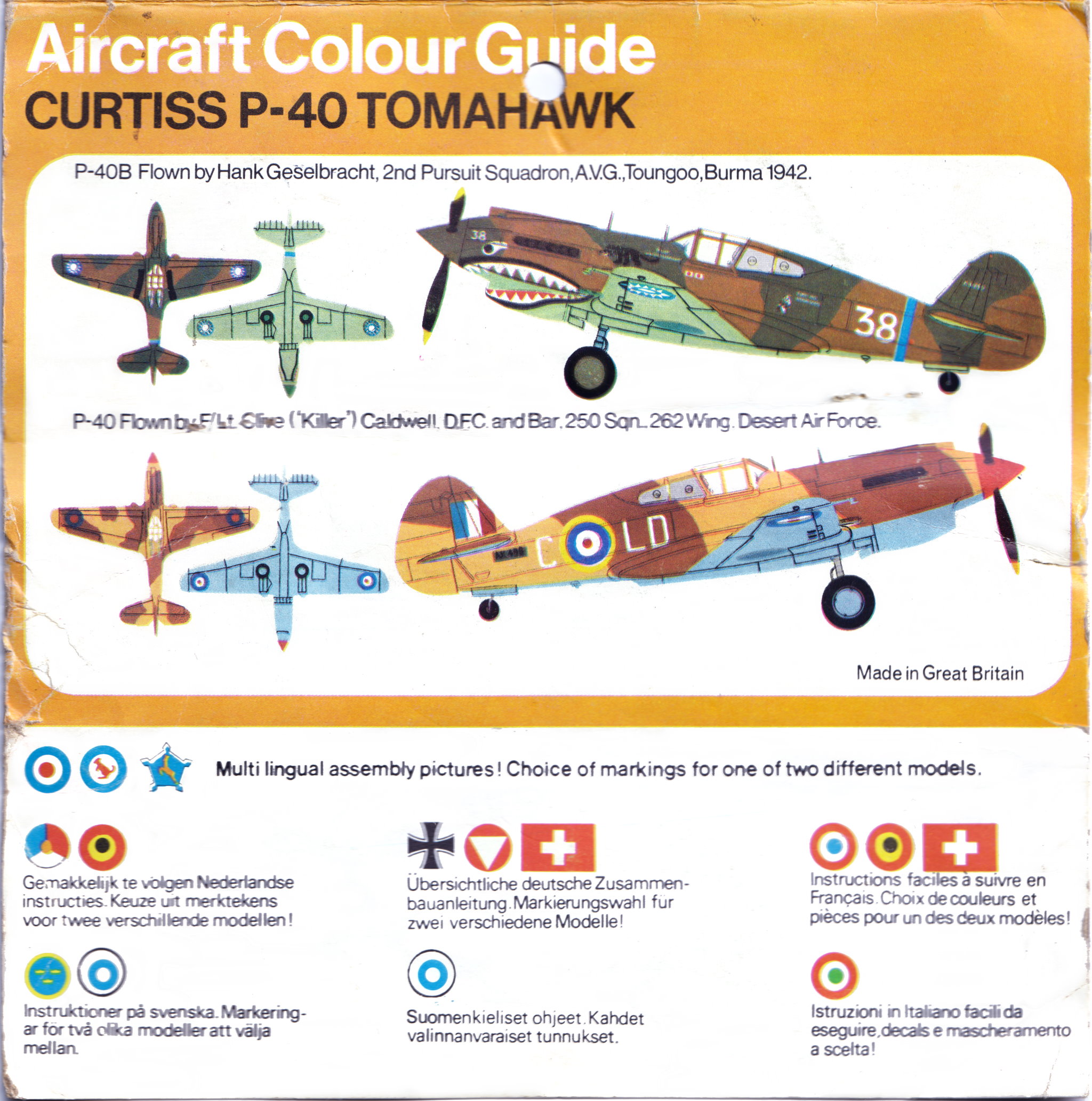
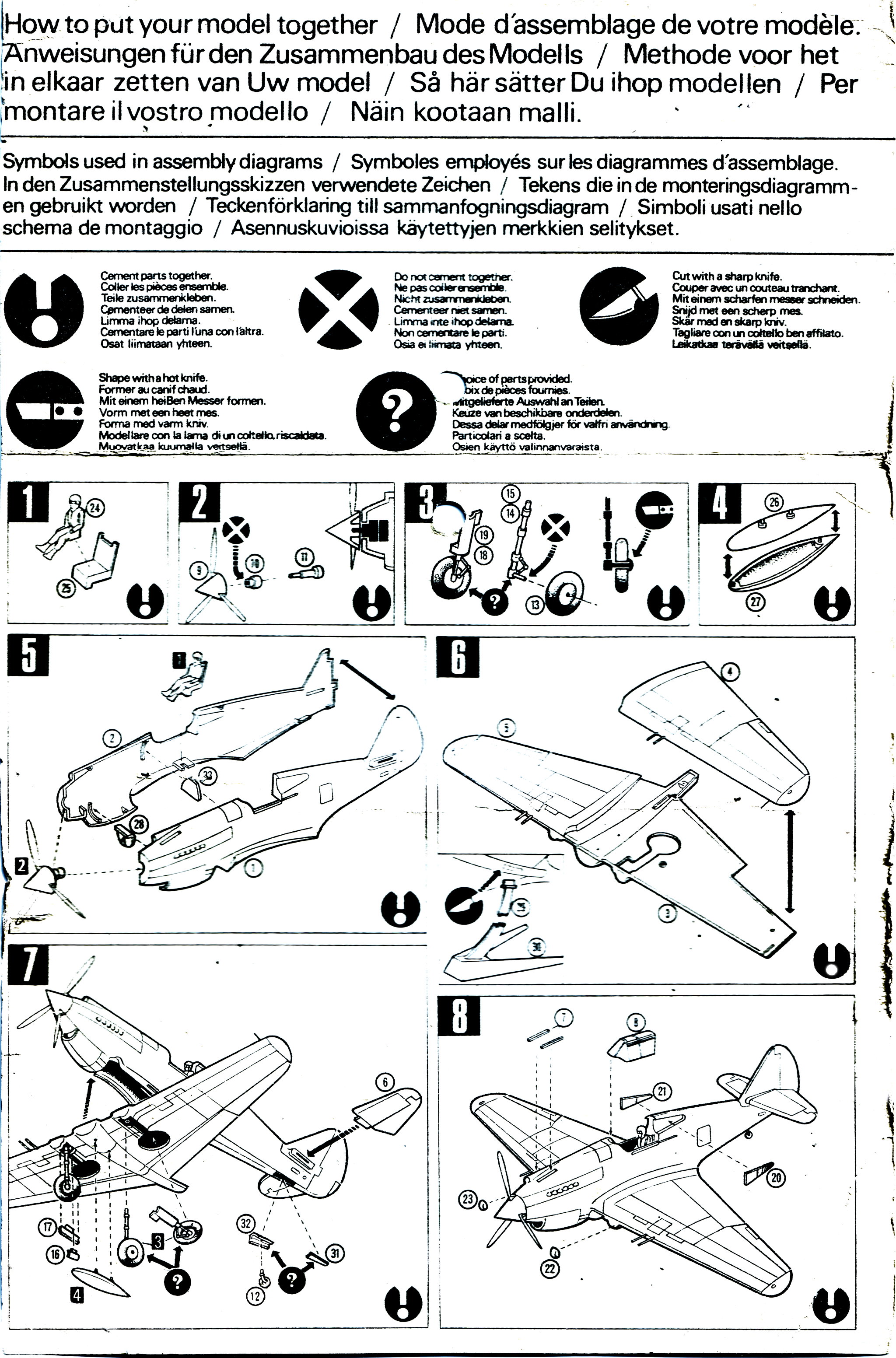
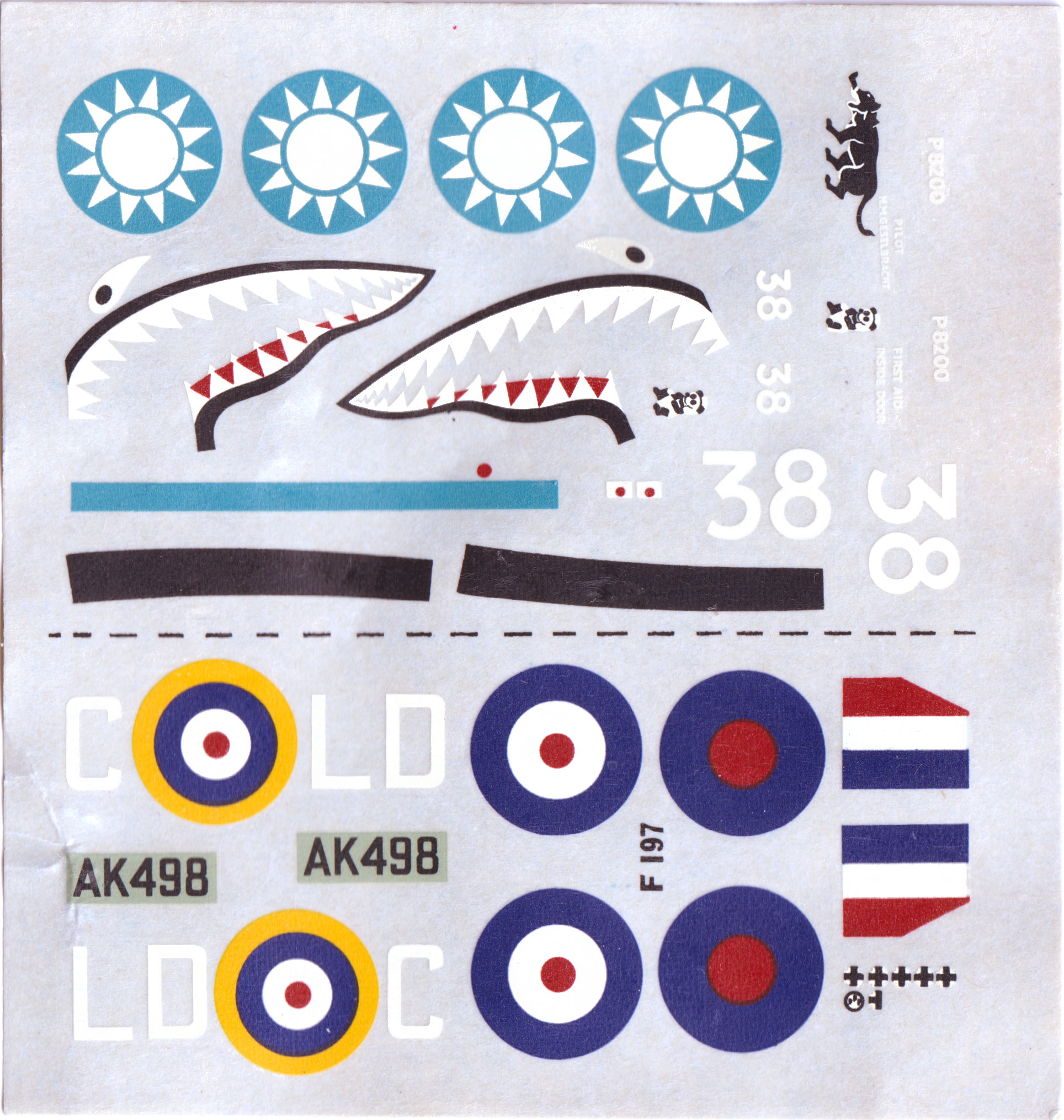
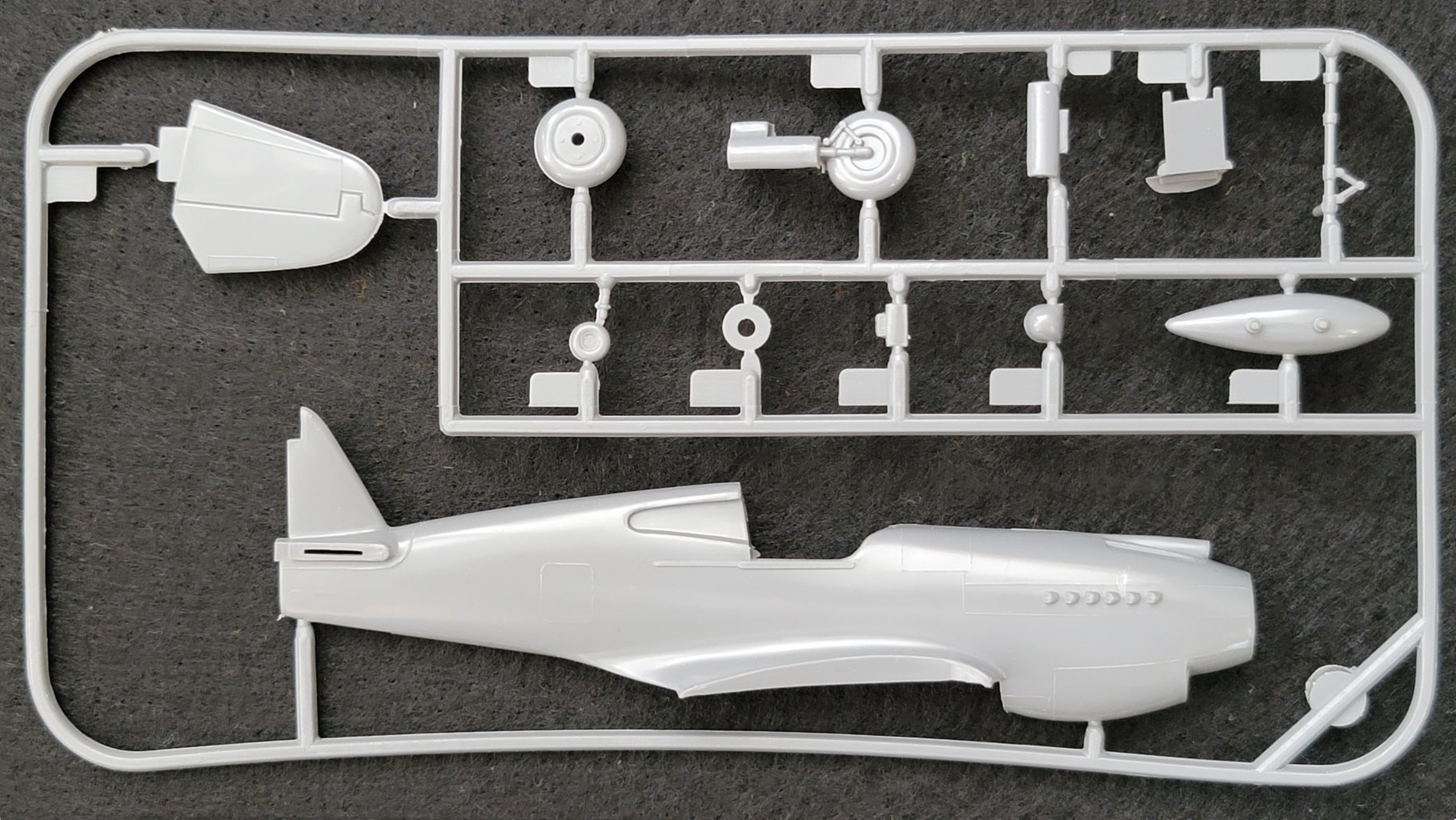
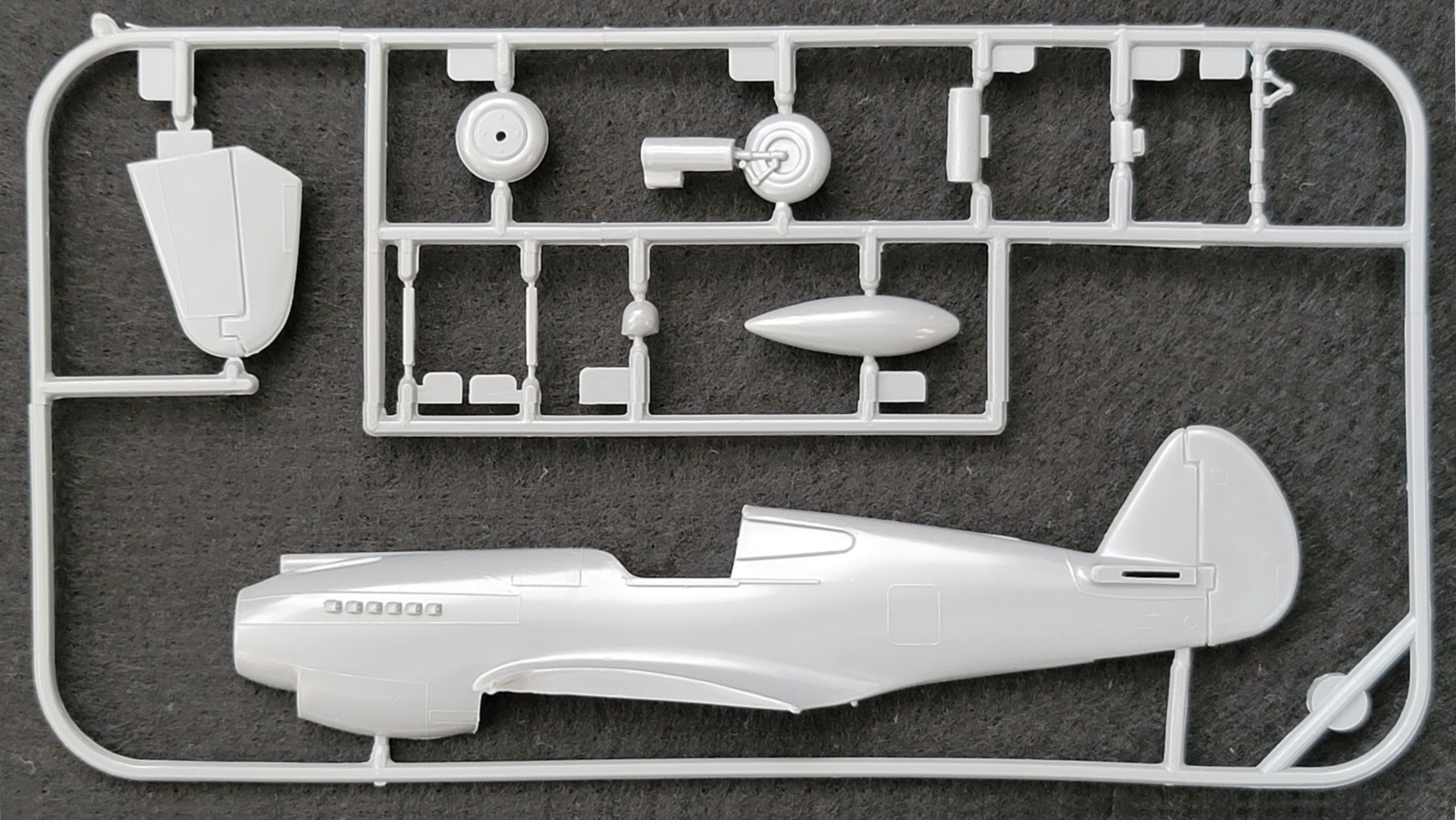
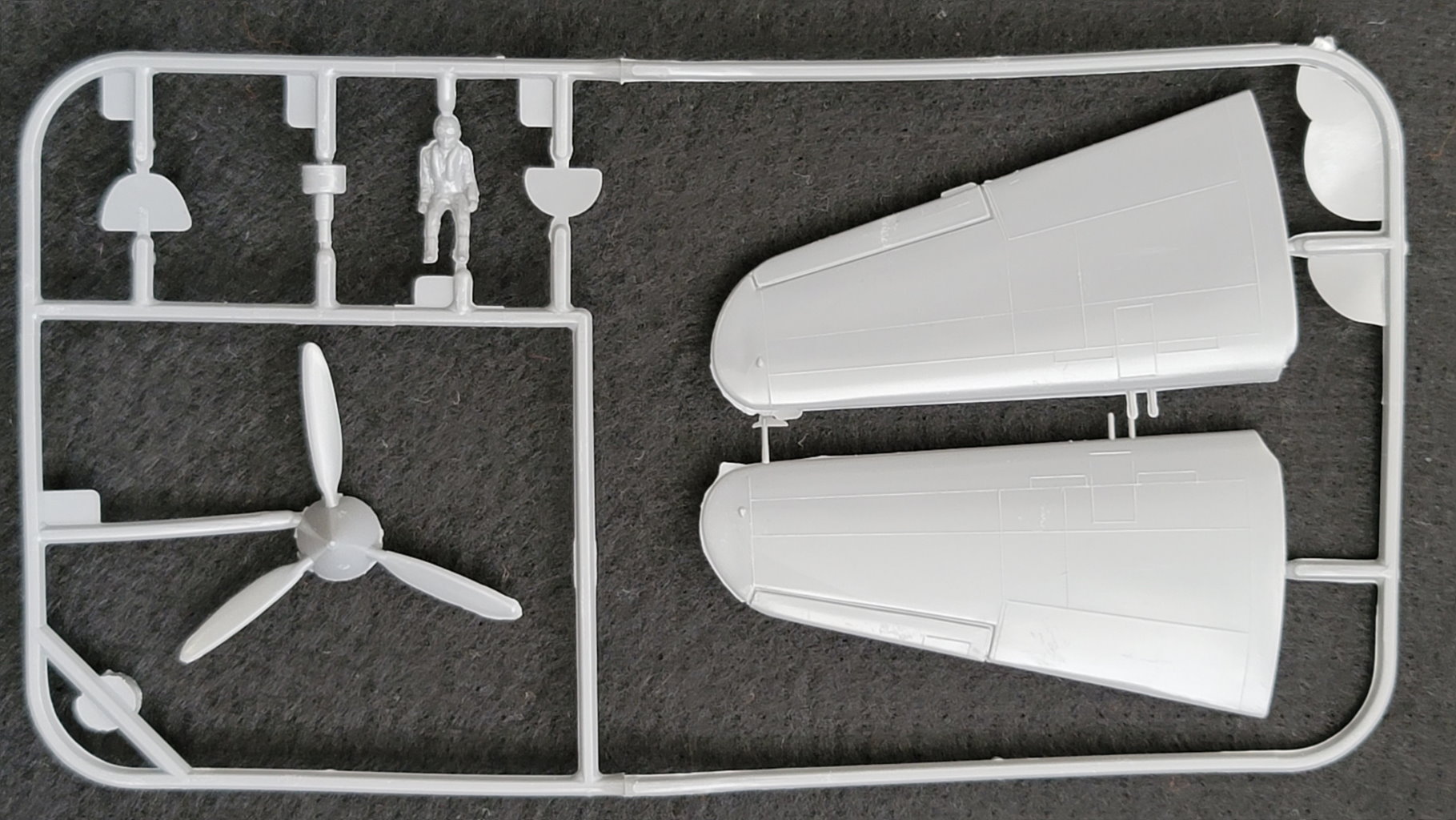
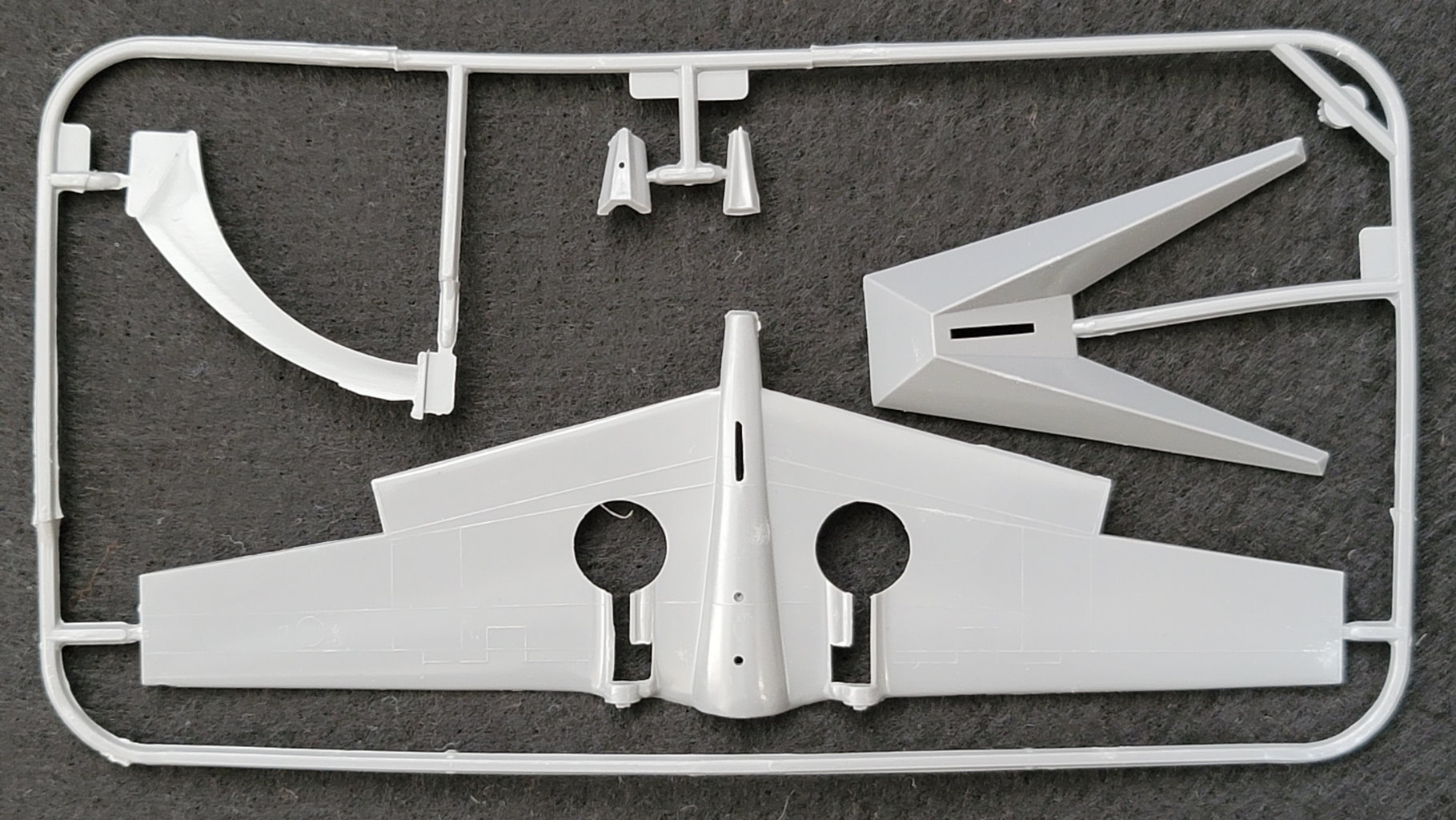

Curtiss P-40B Warhawk (Tomahawk II)
| F197F | 1969-1974 | J2(K) | 285000 | 1xRAF & 1xChinese AF |
| F428 | 1974-1976 | H(B) | 60000 | 1xRAF & 1xChinese AF |
| F197 | 1976-1977 | H(K) | 30000 | 1xRAF & 1xChinese AF |
Originally intended as replacement for the old Kittyhawk kit.
|
|
NEW AND IN VIEW
NEW AIRCRAFT KITS
FROG. Curtiss P-40B Tomahawk. 1/72 scale. Price 3/4 (U.K.)
Fortunately the artwork on the packet in which this kit is contained unmistakably illustrates a Curtiss Tomahawk, and no one can possibly make the error of thinking that this is yet another Kittyhawk or Warhawk model. This is just as well, otherwise some modellers might conceivably overlook this little gem.
The parts are very cleanly moulded in medium grey plastic and surface detail is as good as the best that this company has produced, being comparable to that of their Machi MC202 and re-issued Spitfire II/V. Assembly is very straightforward; the distinctive chin radiator intake is very well represented-no mean feat of tooling this—and outline accuracy is beyong criticism. The distinctive broken-backed fuselage line is well represented, as are the characteristic Curtis wing-tips. The undercarriage is similarly well detailed, the caliper-type shock absorbers being among the best we have seen. Optional parts are included enabling one to choose between an in-flight or parked attitude, even optional open or closed main and tailwheel doors being included. At this price cockpit detail has to be limited to a plain instrument panel and correctly-shaped seat, with the usual Frog blob of a pilot figure. The canopy is excellent; it is crystal-clear, and moulded -intergrally with the windscreen, the smaller rear side panels, each being separate and designed to fit into countersunk grooves in the fuselage. The large intake above the nose accurately follows the shape of that of the original aircraft, while the nose-mounted machine guns are separate fairings; like the rear canopy panels these fit into pre-cut grooves. (Take care when removing them from the sprue not to cut away the barrels of the machine guns protruding from the fairings). The cut-out in the fuselage to take the cockpit canopy is slightly too low on each side and needs very slight packing with plasticard to give the canopy the appearance of being able to be slid back over the upper rear fuselage. Apart from this we cannot fault the mouldings, which on a kit of this price is rare indeed.
The decals, as is normal with all Frog kits these days, are superb. The register is first class,,and they are matt-finished. Markings are given for the aircraft flown by Hank Geselbrecht, of the 2nd Pursuit Squadron American Volunteer Group, Toungoo, Burma, in 1942. They include his Panda Bear motif and leaping leopard Together with the identification numerals 38 and serial P8200. The pale blue of the Chinese Nationalist Air Force wing markings is the nearest we have yet seen to that of the originals. Alternative markings are provided for the Tomahawk of the famous Austrialian 'ace' Clive (Killer) Caldwell, D.F.C. and Bar, when he was with 250 Sqdn., 262 Wing,Desert Air Force. Most interesting, and entirely accurate, is the serial AK498 printed against the original U.K. paint work of RAF dark green; the rest of the machine is of course Dark Earth and Middle-Stone (Midstone), with Azure Blue undersides. Caldwell's 'kill' markings for the period are also given, five and a half Luftwaffe and one Italian, and the markings are completed with the standard RAF roundels and fin flashes of the period.
The packet artwork is also worthy of note, the artist having reproduced the full plan views showing the camouflage patterns, while the side views are port and starboard so that one has a continuity of camouflage pattern from these angles as well. This is an original idea that other manufacturers would do well to adopt. (Note that the dark green areas on the AVG machine appear as dark earth on that flown by Caldwsll).
Summing up this kit, it is excellent, and with very little effort the modeller can readily turn it into a really magnificent model of its subject.
The IPMS magazine, october 1969
TOMAHAWK KIT
IT had to come! ... at last one of the leading manufacturers has produced a 1:72 scale replica of the well known P-40 Tomahawk, after the interminable succession of Kittyhawk and Mohawk kits which have been released over the years.
Selling at 3s, Frog have a winner in this new kit as it is bound to be popular judging by the reception given to its predecessors. We found the model to be delightfully accurate but with one or two minor faults mainly in the construction.
The chief criticism comes in the joint between the wings and fuselage which is very weak and the model maker will have difficulty in getting the right amount of dihedral on the wings as a result.
The other point (though this can hardly be described as a fault) concerns the undercarriage legs which are to scale size and therefore thin and spindly.
The sample we were sent had both legs snapped in transit and needed some careful mending before being ready for assembly.
Two transfer alternatives are supplied, one for an AVG aircraft in Chinese Nationalist markings and the other for Caldwell's aircraft when serving with No 250 Sqn in the Western Desert.
A.W.H.
Airfix magazine 1969-11
NEW to YOU?
MONTHLY REVIEW OF NEW PRODUCTS CONDUCTED BY BOB JONES OF I.P.M.S.
Frog P-40B Tomahawk, we have had kits galore of the later Curtiss P-40E's but this is the first to appear in 1/72nd scale. Of particular note are the excellent decals, the serial being printed against a Dark Green background as on real aircraft. P-40Bs were delivered in U.K. schemes of Dark Green and Dark Earth, finish with Sky Type 'S' undersides. They were repainted Dark Earth and Mid-Stone with Azure Blue undersides. The original Dark Earth was left untouched but the area of the serial was left in the original colouring. Two alternative sets of markings are offered in this kit.
Scale Models No.3 1969 DECEMBER Vol.1 No.3
Modelling world
by James Goulding
Frog's Spitfire XIV and P-40B Tomahawk
TWO new kits have recently been released by Frog—the long-awaited combined kit of a Supermarine Spitfire XIV and Fieseler Fi 103 flying bomb, and the Curtiss P-40B Tomahawk.
Of the two fighter aircraft, the P-40B is much the better model, and very welcome as the first Tomahawk in 1/72nd scale. Kit manufacturers have in the past favoured the P-36 Hawk series or P-40D and 'E Kittyhawks. Personally, I have always thought that the P-40B version was the most pleasing, aesthetically, of this range of Curtiss monoplane fighters. Frog's model has one major error that cannot be corrected. The elevator hinge line sweeps back at an angle, whereas on the full-size aircraft this line was straight across the tailplane. If one is concerned about accuracy, the only solution is to use the tailplane from one of the other P-36 or P-40 kits. The nose contour beneath the radiator is not very accurate, as any side-view photograph shows, but this can be corrected by filing. Another item that requires attention is the propeller which has an unfortunate build-up of plastic behind each blade as a result of the way it is moulded. Removal of this is a tricky operation as the blades are rather delicate.
The hood line is a little low as the framing is level with the top of the fuselage. The fuselage sections aft of the cockpit seem rather on the wide side at the top, which results in the model appearing slightly hump-backed—but again filing helps.
Parts are provided for either lowered or retracted undercarriages. An under-fuselage tank is included.
The transfers are for two P-40s, one of which is the aircraft flown by then Flt Lt Clive Caldwell, DFC and Bar, of 250 Squadron, RAF, 262 Wing. Caldwell was the top-scoring Australian ace with 28 1/2 victories. This P-40, operating with the Desert Air Force, had a Dark Earth and Mid Stone upper surface colour scheme, with Azure Blue undersides. The code and machine letters are white on the transfers. I do not know if Caldwell's aircraft had white letters, but light grey letters were more commonly used at that time.
The alternative transfers are for a P-40B flown by Hank Geselbracht of the 2nd Pursuit Squadron, American Volunteer Group, in Burma. This aircraft was finished in Dark Green/Dark Earth/Sky colour scheme.
Apart from the errors mentioned, this is a generally pleasing little model. On the credit side, I was glad to see that the sharply up-tapered wing tips, always a characteristic feature of the Hawk series, have been reproduced. This was overlooked by several manufacturers in other kits of the P-36/P-40 series.
Price of this kit is 3s, which is more than you pay for the Airfix Kittyhawk, but the transfers in this case are worth at least 2s—so it is good value!
AIRCRAFT Illustrated, December 1969
|




